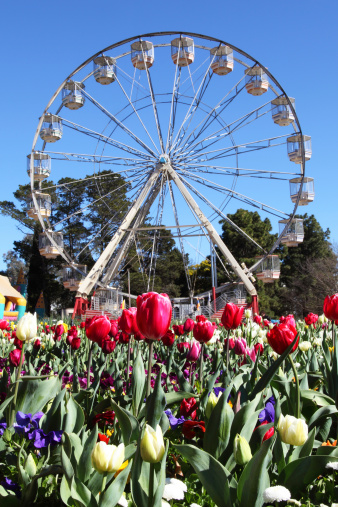Canberra is the capital city of Australia.
That means it is the city where the laws of the country are made.
Australia's Parliament meets in Parliament House.
Australia's capital city
Parliament House, Canberra. The white building in the foreground is the first Parliament House built in Canberra in 1927 © iStock
The city is built on a plain at the foot of the Australian Alps at the northern end of the Australian Capital Territory (ACT).
The city covers an area of 805 square kilometres. About 457 000 people live in the city.
The city was officially named in 1913. Canberra is thought to be a word in a now disappeared Aboriginal language (there are many) meaning 'meeting place'.
We acknowledge the Traditional Custodians of the land on which our National Capital was built, the Ngunnawal people. We respect their Elders, past, present and emerging.
The first people to live in the area were Aboriginal peoples. They had occupied the land for thousands of years before European settlers arrived. The Ngunnawal people lived on the land in the Canberra area. They hunted animals on the plains and in the mountain gullies. They also caught eels, fish and yabbies and ate plants as well as the Bogong moths which were plentiful in summer.
European settlement began in 1820s and there was conflict between settlers and the Ngunnawal people whose land was taken and whose lifestyle was disrupted. By the 1900s when planning began for the development of Canberra most of the Ngunnawal people were living on government reserves.
View across Lake Burley Griffin to the National Carillon which was a gift from the British Government on Canberra’s 50th Anniversary. It is situated on Queen Elizabeth II Island.
©Getty Images
Walter Burley Griffin designed the modern city
A competition was held in 1911 for a design for the city. Architect, Walter Burley Griffin, won the competition and came to oversee construction from 1913 - 1920.
The city is run by the ACT Legislative Assembly which is elected by the people of the city and all other people who live in the ACT.
Floriade is a popular floral festival in Canberra © Getty Images
Canberra is a modern city with many open garden spaces and parklands. Few people live in the city centre. Most live in houses or units in suburbs that surround the city.
There are large shopping centres with cinemas located in the suburbs.
The climate in Canberra
The weather in Canberra is temperate, which means that the summers are warm and the winters are cold. During the summer the average high temperature is about 26C. In winter the average temperature is about 10C.
About one out of every three people who work in Canberra work for the government.
The city is a popular tourist destination and a large number of people are employed in industries such as hotels, restaurants and tour bus companies which cater for the thousands of tourists. The city has many museums and galleries. Floriade is a popular Canberra garden and arts festival and thousands of people visit it.
A view across Lake Burley Griffin to old Parliament House and above it the current Parliament House. Image©Getty
Canberra: A short timeline of European settlement and development 1820 - 2003
1820
Explorers Joseph Wild, James Vaughan and Charles Throsby discovered Limestone Plains, later the site chosen for the national capital
1823
First permanent settlement on the site of the present day Canberra hospital
1848
First school opened in Canberra
1891
Yarralumla homestead built. (Now Government House, the home of the Governor General)
1908
Canberra chosen as the site for the national capital and place for federal government house
1911
Walter Burley Griffin, an architect from Chicago, USA, wins competition to design the capital
1913
The name Canberra chosen for the new city
1923
Work begins to construct parliament house (now referred to as the 'old' parliament house)
1927
Federal Parliament moved to Canberra. (Until now, Federal Parliament had met in Melbourne)
1941
Australian War Memorial opened
The Australian War Memorial in Canberra
1949
Australian National University founded
1959
Academy of Science opened
1964
Lake Burley Griffin created.
1967
Australia's National Gallery established. (It is now the the largest art museum in the country, holding more than 166,000 works of art.)
1973
Building of the National Gallery began (major extensions were completed in 2010)
1975
Building begins for the new High Court of Australia. (Completed in 1980)
1981
Australian Institute of Sport opened
1988
Queen Elizabeth opened the new Parliament House
1993
National Dinosaur Museum opened
2003
Bushfires destroy 70% of the ACT and burn into Canberra. Mt Stromlo Observatory is destroyed.
It’s a good idea to find information from more than one source!
Read more about the city of Canberra
https://www.australiaforeveryone.com.au/australia-for-everyone-canberra/
Read about Parliament House
https://www.aph.gov.au/Visit_Parliament/Things_to_Do/Discover_the_architecture






